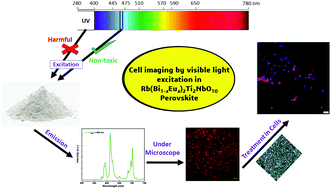Rare-earth ion-activated oxide phosphors are beneficial to overcome problems like photobleaching, reduced lifetime, and the blinking of organic dyes and quantum dots for bioimaging applications. In this work, we report that the phosphors Rb(Bi1−xEux)2Ti2NbO10 (0.025 ≤ x ≤ 0.2) exhibit an electric dipole moment induced sharp 5D0 → 7F2 transition upon blue light excitation with a luminescence lifetime of ∼1 ms. While the major drawback of Eu3+ activated compounds is the requirement of harmful UV excitation, interestingly, this solid solution exhibits a sharp and intense excitation peak at 465 nm (visible light) compared to 363 and 395 nm (UV region), making it viable for bioimaging applications. The sample with x = 0.125 reveals the highest emission intensity with a quantum yield of 10.5%. Temperature-dependent emission spectra of the sample (x = 0.125) reveal excellent thermal stability. The low cytotoxicity of this compound is confirmed by incubation in HeLa cells and SH-SY5Y neuroblastoma cells. The biocompatibility of the compound with SH-SY5Y and HEK293 cells was imaged via two-photon microscopy, indicating its potential for biomedical applications.
